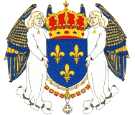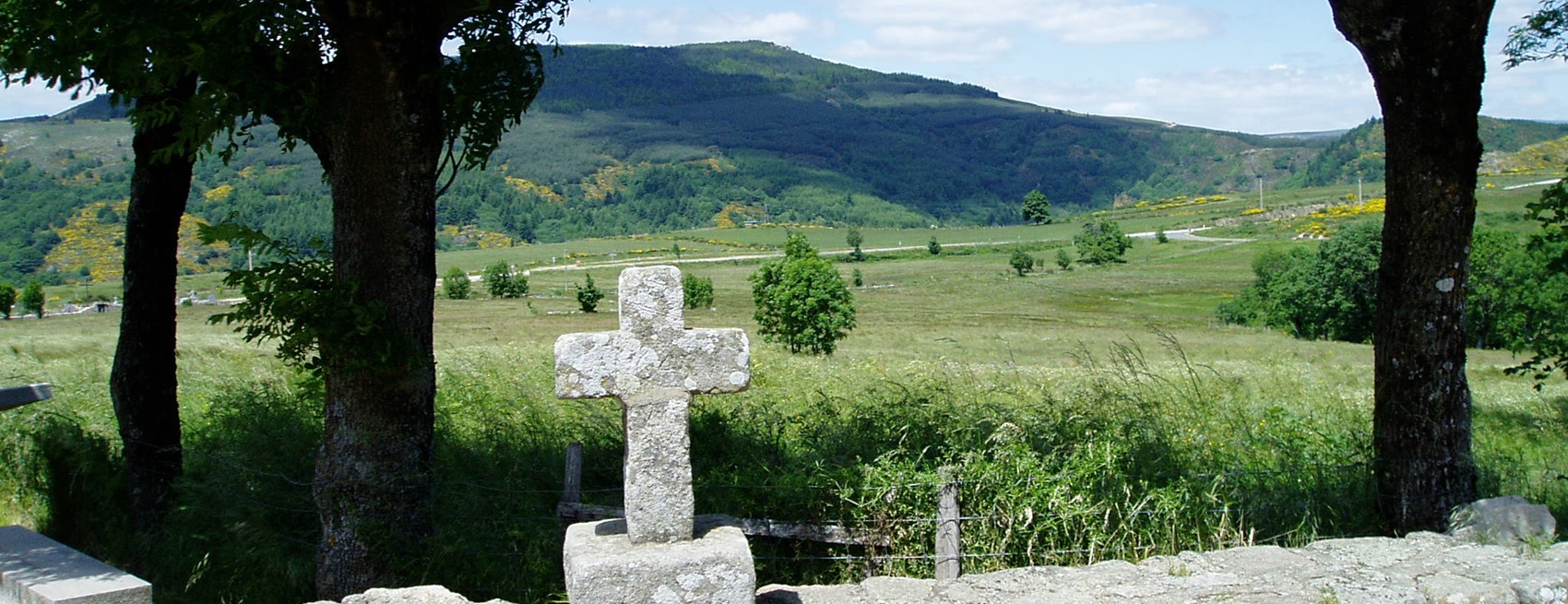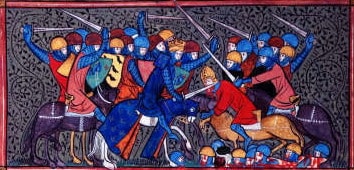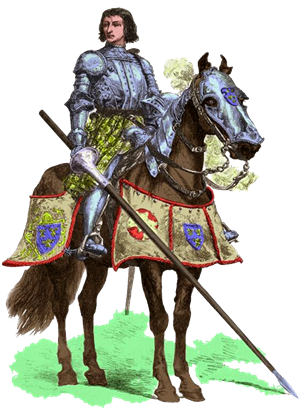


 A kind of road police was therefore ensured in the 11th century, perhaps even before, at La Garde-Guerin. The inhabitants of La Garde maintained a strong garrison and were in charge of guiding and protecting travelers and goods on the GR®700 Voie Regordane that they maintained. In return, they collected tolls. Each of them owned their own lodging or strong house, dominated by the proud silhouette of the square tower still in place.
A kind of road police was therefore ensured in the 11th century, perhaps even before, at La Garde-Guerin. The inhabitants of La Garde maintained a strong garrison and were in charge of guiding and protecting travelers and goods on the GR®700 Voie Regordane that they maintained. In return, they collected tolls. Each of them owned their own lodging or strong house, dominated by the proud silhouette of the square tower still in place.
We know that they had formed an economic and military community and that they lived a kind of co-lordship. In the southern regions, indeed, as Georges Duby writes, “the relations of power are based on the Roman way, on the contract, the “Convenentia” in Latin, on the pacts concluded between free men in respect of the law”. We can think that, at La Garde-Guerin, a regime of co-lordship, which we still know little about today, had been established.
 Every traveler has the right to the road The organization of this community, under the impulse of the lords of Tournel, perhaps had no equal in France. They founded it in the spirit of the Schools of Chivalry, flourishing from the 12th century onwards. There were about ten Schools of Chivalry in France, which are mentioned in important documents of the Royalty. That of La Garde-Guerin was founded as such. The Lords of Tournel wanted to abolish the feudalism that existed in La Garde-Guerin before them and install knights “pariers” - that is, “equals” - (“par” in Latin means “equal”), equal in rights, equal in duties. They shared the lordship of the castle and the chatellany, important revenues and well-defined charges. Each parier owned a parerie or a share of the castle and its territory.
Every traveler has the right to the road The organization of this community, under the impulse of the lords of Tournel, perhaps had no equal in France. They founded it in the spirit of the Schools of Chivalry, flourishing from the 12th century onwards. There were about ten Schools of Chivalry in France, which are mentioned in important documents of the Royalty. That of La Garde-Guerin was founded as such. The Lords of Tournel wanted to abolish the feudalism that existed in La Garde-Guerin before them and install knights “pariers” - that is, “equals” - (“par” in Latin means “equal”), equal in rights, equal in duties. They shared the lordship of the castle and the chatellany, important revenues and well-defined charges. Each parier owned a parerie or a share of the castle and its territory.
Little and rarely was written at that time and the first text that mentions the inhabitants of La Garde-Guerin is found in a curious manuscript known as the “Book of Saint-Privat”. It is written in Latin, by the hand of the bishop, Aldebert III of Tournel, nicknamed The Venerable. Aldebert III was elected between 1150 and 1158, and he died in 1187, prisoner of one of his brothers, a bastard, and locked up in the castle of Chapieu that the said bishop had built to defend the city of Mende. This text was translated and commented by the abbot Roux, priest of Vialas. “There is in the bishopric of Mende, near the public road called Regordane, a castle called La Garde, which was always not a castle but a cave. Brigands dwelled there indeed and undertook frequent expeditions day and night, stripped travelers of their goods, wounded them, left them half-dead and very often killed them. Every day, there were perpetrated rapines, thefts, homicides and other crimes”. The neighboring bishops and especially the bishop of Mende, to whom it was incumbent, attacked this dismal den without being able to completely abolish the inveterate bad customs. The bishop Aldebert knowing this verse: “Every traveler has the right to the road everywhere”, put the finishing touch to the repression of this scourge.
 The castle was threatened not only by ecclesiastical censorship, but by arms. The inhabitants, struck with terror, surrendered on the appointed day for the “satisfaction”, they came to Mende to throw themselves at the feet of the bishop, not only the knights and their sons, but even the young and old serfs. In the presence of all the people, they abandoned their bad acquisitions and their bad customs, and then all swore, on the Holy Gospels, that from then on they would demand nothing from the travelers frequenting this road, that they would do them no violence, nor cause them any vexation. After which, penance for the past once accepted, they withdrew.
The castle was threatened not only by ecclesiastical censorship, but by arms. The inhabitants, struck with terror, surrendered on the appointed day for the “satisfaction”, they came to Mende to throw themselves at the feet of the bishop, not only the knights and their sons, but even the young and old serfs. In the presence of all the people, they abandoned their bad acquisitions and their bad customs, and then all swore, on the Holy Gospels, that from then on they would demand nothing from the travelers frequenting this road, that they would do them no violence, nor cause them any vexation. After which, penance for the past once accepted, they withdrew.
Aldebert III spent most of his episcopate fighting against the lords to consolidate the temporal power of the bishops of Mende still faltering. The Count of Barcelona to the southwest of the cathedral, the Lord of Canilhac to the west, the Lord of Cabrieres to the west, the Lord of Dolan to the south, had built fortified dwellings and threatened the papal supremacy. He even ended up claiming the right that was disputed to him of suzerainty over the silver mines of the country. He had a village restored by the castellans of Plagniol, obliged Garin de Châteauneuf to return another one that he had taken from the hospital of Mende. He brought Ricard de Peyre back to order.
The tutelage of the King of France Exasperated by this life of repression, he went in 1166 to the court of the King of France Louis VII and paid homage to him for the first time for his bishopric, in exchange for the promise of royal protection. This famous act was designated under the name of “Golden Bull”. Naturally all the feudal lords of the region rose up against this pact which, by making the king the supreme lord of Gevaudan, threatened them with a tutelage more difficult to shake off than that of the local bishops. They stirred up troubles that lasted until around 1170.
 In light of all these events, should we take Aldebert’s account at face value? Did the bishop not want to justify his position? Were the brigands of La Garde as black as he said in the text?
In light of all these events, should we take Aldebert’s account at face value? Did the bishop not want to justify his position? Were the brigands of La Garde as black as he said in the text?
As always, in such cases, one must sort out the facts. The “knights” were surely not bandits, let alone saints, but rather formidable characters occupying a prominent fortress, placed in a good location, near the Regordane". Following his victory, Aldebert III seized a number of pareries and gave these lords a status that we do not know, for lack of written documents. Let us recall that at that time all power was expressed mainly by word and gesture. Later, in 1238, in a text written in Latin, “Additions to the statutes of Bishop Etienne” by Raymond Atger, official of the said bishop, we can read this: “As Etienne, bishop of Mende, main lord of the castle of La Garde, had come to this castle for his affairs, the knights and pariers of the castle presented themselves before him and thus asked, because discord often occurred among them about the customs of the castle, to have written down the rules that he thought should be observed in the future in litigious cases”.
 For a long time, the sources of income of the papers came mainly from their rights of toll, guidance, rear-guidance on the Voie Regordane and cartage on the common domain. The toll was due by the passers-by, their animals and their goods and originally intended for the maintenance of the road. The guidance and rear-guidance were perceived for the protection of the merchants and their convoys. The cartage was paid by the farmers of the common domain for the measurement of the grains. Each parier owned a portion or parerie of the castle and its territory, and the revenues were shared proportionally to the number of pareries they owned and according to the effective role of each one in the surveillance of the road, that is to say the time spent at the castle. As the members of the community became more numerous, the revenues, sufficient at the origin, were no longer in relation with the charges that entailed the maintenance of the road and the police service. Quarrels broke out among them. The inheritance issues became more and more complex… some families left La Garde-Guerin and made way for newcomers… The co-lordship was threatened with crumbling. The bishops promulgated regulations intended to stop the dismemberment of the fief and, in a general way, to define the rights of each parier in the community.
For a long time, the sources of income of the papers came mainly from their rights of toll, guidance, rear-guidance on the Voie Regordane and cartage on the common domain. The toll was due by the passers-by, their animals and their goods and originally intended for the maintenance of the road. The guidance and rear-guidance were perceived for the protection of the merchants and their convoys. The cartage was paid by the farmers of the common domain for the measurement of the grains. Each parier owned a portion or parerie of the castle and its territory, and the revenues were shared proportionally to the number of pareries they owned and according to the effective role of each one in the surveillance of the road, that is to say the time spent at the castle. As the members of the community became more numerous, the revenues, sufficient at the origin, were no longer in relation with the charges that entailed the maintenance of the road and the police service. Quarrels broke out among them. The inheritance issues became more and more complex… some families left La Garde-Guerin and made way for newcomers… The co-lordship was threatened with crumbling. The bishops promulgated regulations intended to stop the dismemberment of the fief and, in a general way, to define the rights of each parier in the community.
Parier from the age of 16
The statutes of Bishop Odilon de Mercoeur in 1260 define one of the most original road institutions of the Middle Ages. To prevent too much dismemberment, the number of “pareries” or portions of a parier is limited. Each one will remain indivisible and will return to a single heir. In principle, the parier must be able to bear arms and ensure the police of the road. When the father is no longer able to serve, he resigns in favor of his son, the eldest preferably. He then - and alone among his brothers - ceases to be a damsel. He receives the knighthood and becomes a knight. A knight can be a parier from the age of 16, because he is of age at 16 and not at 20 for the damsels. He has a full share from then on in the charges and revenues. A daughter inherits the parerie only if she has a husband capable of replacing her to bear arms. The parerie is alienated by an act of sale, accompanied by the investiture of the bishop who keeps the right to “retain this parerie”. The knight pariers (they were 31 in 1258) elected four of their own who, in their name and in the name of all the pariers, agreed with the bishop to bring back peace or correct the existing statutes. These four knights represent the four families of the castle: the Gaucelme, Erailh, Bertrand and Gaule (or Gal). It was a question for these “powerful” barons and bishops, to master this cumbersome “power” in peacetime in order to better neutralize each other in a muffled or violent confrontation for centuries.
 Moreover, the bishop decided that every year two consuls would be elected who would act in fidelity and legality, defend the rights of the castle and its district, demand the rents and general revenues, exercise the right of jurisdiction. These consuls had to swear an oath of allegiance in the hands of the bishop or his delegate. They took the title of “Noble Consuls”. When Guillaume Durand occupied the bishopric of Mende, his many vassals paid him homage. Jourdan de La Garde, one of the consuls, in the name of the community of noble pariers, renewed this act.
Moreover, the bishop decided that every year two consuls would be elected who would act in fidelity and legality, defend the rights of the castle and its district, demand the rents and general revenues, exercise the right of jurisdiction. These consuls had to swear an oath of allegiance in the hands of the bishop or his delegate. They took the title of “Noble Consuls”. When Guillaume Durand occupied the bishopric of Mende, his many vassals paid him homage. Jourdan de La Garde, one of the consuls, in the name of the community of noble pariers, renewed this act.
 A precise ceremony On December 2, 1292, at the request of Guillaume de Montesquieu, the bailiff of the bishop, the pariers handed over the castle to him. Indeed, the castle had to be returned at each election of bishops, in times of war and whenever the circumstances and necessity required it. The delegate of the prelate, after receiving the keys, closed and opened the doors and took possession of them. Then he hoisted the banner of Saint-Privat on the tower. A herald, placed next to the episcopal standard, shouted loudly and repeatedly: Saint-Privat for Monseigneur the bishop of Mende! Saint-Privat for Monseigneur the bishop of Mende! Saint-Privat! God wills it! Deus o vol! After that, the representative of the bishop handed over the keys of the castle to the consuls, and withdrew.
A precise ceremony On December 2, 1292, at the request of Guillaume de Montesquieu, the bailiff of the bishop, the pariers handed over the castle to him. Indeed, the castle had to be returned at each election of bishops, in times of war and whenever the circumstances and necessity required it. The delegate of the prelate, after receiving the keys, closed and opened the doors and took possession of them. Then he hoisted the banner of Saint-Privat on the tower. A herald, placed next to the episcopal standard, shouted loudly and repeatedly: Saint-Privat for Monseigneur the bishop of Mende! Saint-Privat for Monseigneur the bishop of Mende! Saint-Privat! God wills it! Deus o vol! After that, the representative of the bishop handed over the keys of the castle to the consuls, and withdrew.
In the text written in Latin of the statutes of Raymond Barrot, vicar general of Guillaume Durand, dated February 7, 1299, we can read “consules castri de Garda Gary”: the consuls of the castle of La Garde Gary. This is the first time, to our knowledge, that we speak of La Garde Gary (Garin or Guerin later). In the early years of the 14th century, when the royal commissioners drew up the enumeration of the fiefs of Gevaudan, the pariers of La Garde hastened to declare those they held from the church of Mende. In 1307, a treaty of pareage was concluded between Philippe le Bel and the bishop of Mende. This act made the authority of the King of France penetrate further into Gevaudan and the Count-Bishop of Gevaudan asserted his suzerainty over La Garde-Guerin. The statutes of 1310 brought profound changes. A common court to the king and the bishop was established and from then on, thanks to the fear of its judgments and the progress of morals, order reigned in Gevaudan. We can suppose that the community of pariers is no longer then an organ necessary for public tranquility, and that it loses the military and police character, already attenuated, that it had at the origin. It no longer exercises the police service that it exercised and no longer perceives the rights that were attached to it.
From then on, it is understandable that, in the statutes of 1310, all the old provisions disappear, because they tended mainly to ensure the functioning of this service. The community loses its privileges and ceases to be what it had been. The bishops of Mende ensure more and more the preponderance in the community. They manage to hold a large number of pareries, to gradually oust the barons of Tournel who had been at the origin the only direct suzerains of the pariers, and to predominate in the community. Association G.A.R.D.E, La Garde-Guerin, 48800 Villefort
***
 Let me tell you the story of the Parier Knights of La Garde-Guerin in Lozere.
Let me tell you the story of the Parier Knights of La Garde-Guerin in Lozere.
In the 11th century, in La Garde-Guerin, a village located in the Occitanie region, a kind of road police was in place. The inhabitants of La Garde had the responsibility of guiding and protecting the travelers and their goods on the GR®700 Voie Regordane, an ancient communication route. In exchange for these services, they collected tolls. Each inhabitant owned his own strong house, and the imposing silhouette of the square tower still bears witness to this era.
 But what makes the Knights of La Garde-Guerin so fascinating is their unique organization. Under the impetus of the Lords of Tournel, they created an economic and military community inspired by the flourishing Knight Schools of the 12th century. Unlike traditional feudalism, the Knights of La Garde-Guerin were equals in rights and responsibilities. They shared the lordship of the castle and the lordship, as well as the associated income and duties. Each knight owned a portion of the castle and its territory.
But what makes the Knights of La Garde-Guerin so fascinating is their unique organization. Under the impetus of the Lords of Tournel, they created an economic and military community inspired by the flourishing Knight Schools of the 12th century. Unlike traditional feudalism, the Knights of La Garde-Guerin were equals in rights and responsibilities. They shared the lordship of the castle and the lordship, as well as the associated income and duties. Each knight owned a portion of the castle and its territory.
The first text mentioning the inhabitants of La Garde-Guerin is found in a manuscript called the “Book of Saint-Privat,” written in Latin by Bishop Aldebert III of Tournel. This text describes La Garde-Guerin as a den of brigands who attacked travelers, committing robberies, thefts, and even homicides. The Lords of Tournel founded this community of Knights of La Garde-Guerin to put an end to these bad customs.
Thus, in La Garde-Guerin, these Knights of La Garde-Guerin have left their mark on history, protecting travelers on the Regordane road. The 27-meter-high keep still bears witness today to their presence and commitment.
If you wander through this picturesque region of Lozere, don’t hesitate to imagine these valiant Knights of La Garde-Guerin watching over travelers, guiding their steps, and defending everyone’s safety.
Old romantic Hotel, L'Etoile Guest-House is a mountain retreat in the South of France. With a beautiful park along the Allier River, L'Etoile Guesthouse is located in La Bastide-Puylaurent between Lozere, Ardeche and Cevennes. Many hiking trails like GR®7, GR®70 Stevenson trail, GR®72, GR®700 Regordane way, Cevenol, GR®470 Allier river, Margeride. Many hiking loops. The right place to relax.
Copyright©gr-infos.com